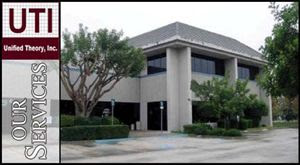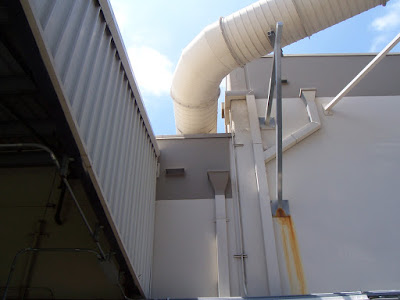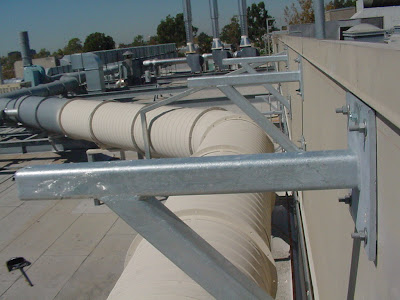What is the purpose of a ventilation system?
There are four purposes of ventilation:
1. Provide a continuous supply of fresh outside air.
2. Maintain temperature and humidity at comfortable levels.
3. Reduce potential fire or explosion hazards.
4. Remove or dilute airborne contaminants.
Why have an industrial ventilation system?
Ventilation is considered an "engineering control" to remove or control contaminants released in indoor work environments. It is one of the preferred ways to control employee exposure to air contaminants.
Other ways to control contaminants include:
* eliminate the use of the hazardous chemical or material,
* substitute with less toxic chemicals,
* process change, or
* work practice change.
What are the parts of an industrial ventilation system?
Systems are composed of many parts including:
* an "air intake" area such as a hood or an enclosure,
* ducts to move air from one area to another,
* air cleaning device(s), and
* fan(s) to bring in outside air and exhaust the indoor contaminated air.
Each of these parts are discussed in this series of documents.
What are the basic types of ventilation systems?
There are two types of mechanical ventilation systems used in industrial settings:
Dilution (or general) ventilation reduces the concentration of the contaminant by mixing the contaminated air with clean, uncontaminated air.
Local exhaust ventilation captures contaminates at or very near the source and exhausts them outside.
Let Unified Theory Inc. of Camarillo, CA help you with your next Industrial Process, Mechanical, Structural or Electrical project.
Our team of engineers can handle almost any industrial process system design.
Whether your project is for conveyor controls, emission controls, exhaust systems, air handling systems, fluid systems, materials handling systems or high speed manufacturing, UTI can handle it all.
Our team of engineers can handle almost any industrial process system design.
Whether your project is for conveyor controls, emission controls, exhaust systems, air handling systems, fluid systems, materials handling systems or high speed manufacturing, UTI can handle it all.
Engineering Consultants in Southern California
|
| ||
|
|

| |
UTI offers a full range of industrial and commercial architectural services, including project management, construction management and training.
Inbox Robot: Industrial Goods Industry News
Friday, August 22, 2008
5 advantages and disadvantages to using dilution ventilation fo Industrial Ventilation
The advantages are:
(1) Usually lower equipment and installation costs.
(2) Needs less maintenance.
(3) Good control for small amounts of low toxicity chemicals.
(4) Effective control for flammable or combustible gases or vapors.
(5) Best ventilation system for small dispersed contaminant sources or mobile sources.
The disadvantages are:
(1) Cannot be used for highly toxic chemicals.
(2) Does not completely remove contaminants.
(3) Not good for handling surges of gases or vapors or irregular emissions.
(4) Not effective for dusts or metal fumes or large amounts of gases or vapors.
(5) Requires large amounts of heated or cooled makeup air.
(1) Usually lower equipment and installation costs.
(2) Needs less maintenance.
(3) Good control for small amounts of low toxicity chemicals.
(4) Effective control for flammable or combustible gases or vapors.
(5) Best ventilation system for small dispersed contaminant sources or mobile sources.
The disadvantages are:
(1) Cannot be used for highly toxic chemicals.
(2) Does not completely remove contaminants.
(3) Not good for handling surges of gases or vapors or irregular emissions.
(4) Not effective for dusts or metal fumes or large amounts of gases or vapors.
(5) Requires large amounts of heated or cooled makeup air.
3 types of workplace Industrial ventilation systems

(1) "Indoor air quality ventilation" used mainly to provide fresh, heated or cooled air to buildings as part of the heating, ventilating and air-conditioning system,
(2) "Dilution ventilation" which dilutes contaminated air in a whole building or room by blowing in clean air and exhausting some dirty air,
(3) "Local exhaust ventilation" which captures contaminate emissions at or very near the source and exhausts them outside.
Indoor air quality ventilation, used primarily in offices and other non-industrial buildings, will not be covered in this guideline.
There are advantages and disadvantages to the use of either dilution ventilation or local exhaust ventilation in terms of costs and effectiveness.
Industrial ventilation - what is it?
Industrial ventilation is a method of controlling worker exposure to airborne toxic chemicals or flammable vapors by exhausting contaminated air away from the work area and replacing it with clean air.
One alternative to control employee exposure to air contaminants in the workplace.

Other alternatives include process changes, work practice changes, substitution with less toxic chemicals, or elimination of the use of toxic chemicals. Industrial ventilation is typically used to remove welding fumes, solvent vapors, oil mists or dusts from a work location and exhaust these contaminants outdoors.
The design and troubleshooting of industrial ventilation systems should be handled by a qualified ventilation engineer or firms specializing in this field.
One alternative to control employee exposure to air contaminants in the workplace.
Other alternatives include process changes, work practice changes, substitution with less toxic chemicals, or elimination of the use of toxic chemicals. Industrial ventilation is typically used to remove welding fumes, solvent vapors, oil mists or dusts from a work location and exhaust these contaminants outdoors.
The design and troubleshooting of industrial ventilation systems should be handled by a qualified ventilation engineer or firms specializing in this field.
Subscribe to:
Comments (Atom)
